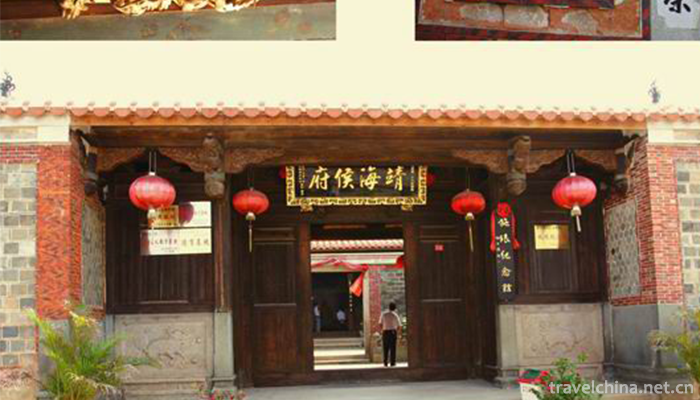Construction Techniques of Traditional Residential Buildings in Southern Fujian
Construction Techniques of Traditional Residential Buildings in Southern Fujian
South Fujian residential building technology is a unique traditional architectural technology originating in Quanzhou, which began in Tang and Five Dynasties, is the mainstream of ancient architectural technology in South Fujian, and spread in Quanzhou, Zhangzhou, Xiamen, Taiwanese, Hong Kong, Macao and Southeast Asia in the cultural circle of South Fujian.
The official Dacuo, commonly known as the "Palace Rise", is the most typical type in Quanzhou. It can be seen everywhere in the overseas Chinese hometown of Quanzhou. Its representative works include the ancient residence of Cai's family in Nan'an, a national cultural relic protection unit, and the former residence of Yang A Miao, a cultural relic protection unit in Fujian Province.
brief introduction
What is "Building Skills of Minnan Residential Buildings"
Southern Fujian dwelling belongs to a school of traditional Chinese courtyard dwelling. It is a type of dwelling with the most advanced material use and structural technology, the most abundant constituent factors, the most complex level of "ritual" and the most diverse decoration.
The construction techniques of folk houses in southern Fujian are divided into big wood work, small wood work, tile work, brick and stone work, paint work, color painting, stacking and cutting work, among which big wood work is the most important. Craftsmen are also classified and divided according to their types of work, with large carpenters as the core.
characteristic
This technique originated in Quanzhou and is the mainstream of ancient architectural techniques in southern Fujian.
Morning Post News (reporter Zhang Suping) Quanzhou Nanyin, Quanzhou Li Yaobao carved paper has been selected into the world's "non-heritage" list, but little known is that the Quanzhou Museum initiated the election of the Southern Fujian residential construction skills are also included in the world's "non-heritage"!
Reporters learned yesterday that from August 19 to 20, China was selected as the UNESCO "intangible cultural heritage of mankind" project certification ceremony and Protection Forum was held in Beijing. Chinese traditional wooden structure construction techniques are listed in the "non-legacy" list of the world, and southern Fujian residential construction techniques, as one of its three major skills, are also included.
Yao Hongfeng, renovator of the International Ancient Architecture of Quanzhou Cultural Relics Conservation Research Center, said that the traditional Chinese wooden structure construction technology is "bundled" together with the construction technology of three provinces in China and jointly declared. Fujian Province is one of them, and Quanzhou is the only city in Fujian Province to participate in the merger.
In fact, the declaration work started as early as 2008. "We take Yang'a Miao Residence as a representative building, and have produced relevant text, pictures and video materials to introduce the building techniques of Minnan Residence." Chen Jianzhong, curator of Quanzhou Museum, said that the building skills of folk houses in southern Fujian originated from Quanzhou, and the staff took Yang A Miao's building skills as a model to "elaborate" the skills. This skill is a sub-item of "Chinese traditional wooden structure construction skill". Perhaps it caused this skill to be selected into the world "non-legacy", but for a long time "raised in the boudoir people do not know".


-
1.Online Shopping
Online shopping is to retrieve commodity information through the Internet, and send out shopping requests through electronic order forms, then fill in the number
Time 2018-11-13 -
2.Enshi Grand Canyon
Enshi Grand Canyon is located in Tunpu Township and Banqiao Township, Enshi City, Hubei Province. It is located at the junction of Hunan, Chongqing and Hubei provinces. It is the most beautiful sectio
Time 2018-12-12 -
3.Nanxi Mountain Scenic Area Guilin
Guilin Nanxi Mountain Scenic Area (that is, Guilin Nanxi Mountain Park) is located in the south of Guilin City, about 1 kilometer north of the railway station. The two peaks of Nanxi Mountain confront
Time 2019-01-13 -
4.Weihai Tianmu Hot Spring Resort
Tianmu Hot Spring Resort Project invested 600 million yuan by Zhuhai Tianmu Group. A total of 35,000 square meters were opened in September 2008.
Time 2019-02-22 -
5.Changlu Tourist Xiubo Garden Scenic Area
Changlu Tourist Xiubo Park, or Changlu Environmental Resort Farm (hereinafter referred to as "Changlu Farm"), became the national 5A scenic spot in November 2014. It is the only national 5A
Time 2019-03-17 -
6.Amber carving
Fushun Amber, a special product of Fushun City, Liaoning Province, is a national geographical indication product of China.
Time 2019-05-03 -
7.Jianchuan Opera
Jianchuan Baiqu is an ancient music variety with a long history and wide spread in Bai nationality area. It is mainly popular in Jianchuan, Eryuan and Tongdian, Jinding and Jiuhe of Lanping County, Nu
Time 2019-05-05 -
8.Liao Zhais folk songs
The spreading area of Liaozhai slang mainly distributes in Zibo City, Shandong Province. The Pu family and its descendants are the main inheritors. Liaozhai slang is a unique traditional folk music li
Time 2019-05-13 -
9.Naxi Remei Biao
"Remei Biao" is also known as "Wo Yo Ye", which is a collective folk custom that has been spreading for thousands of years. There are more than ten people at least and hundreds of
Time 2019-06-07 -
10.acrobatics on a high flag pole
The banner is a kind of flag with different sizes. Zhongbian is a kind of flag with gorgeous decoration, honor features and competition strength. Zhongbian originated from the flagpole of the Royal Gu
Time 2019-08-03 -
11.China Foreign Affairs University
China Foreign Affairs University is a small scale, high level and distinctive foreign ministry's sole institution directly under the guidance of serving the cause of China's diplomacy and cultivating
Time 2019-11-29 -
12.Qingyang Palace
Qingyang palace is located in the second section of the first ring road in Chengdu, Sichuan Province. It is known as "the first Taoist temple in Western Sichuan" and "the first jungle in Southwest China". It is also one of the famous Taoist temples in China.
Time 2020-11-05